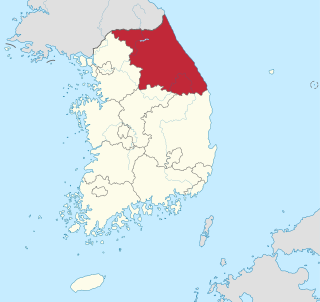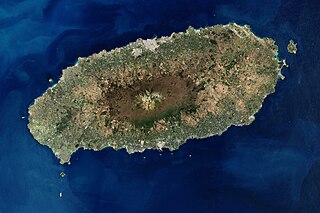Related Research Articles

Gangwon Province is a province of South Korea and the least densely populated subdivision of the country. Gangwon is one of the two provinces with self-governing status, the other being Jeju-do. On the east bound by the East Sea, it borders Gyeonggi Province to its west, North Gyeongsang Province and North Chungcheong Province to its south, and the Military Demarcation Line to the north, separating it from North Korea's Kangwŏn Province. Before the division of Korea in 1945 Gangwon and Kangwŏn Provinces formed a single province.

Gyeonggi Province is the most populous province in South Korea. Its name, Gyeonggi, means "京 and 畿 ". Thus, Gyeonggi-do can be translated as "Seoul and the surrounding areas of Seoul". Seoul, the nation's largest city and capital, is in the heart of the area but has been separately administered as a provincial-level special city since 1946. Incheon, the nation's third-largest city, is on the coast of the province and has been similarly administered as a provincial-level metropolitan city since 1981. The three jurisdictions are collectively referred to as Sudogwon and cover 11,730 km2 (4,530 sq mi), with a combined population of over 26 million - amounting to over half (50.25%) of the entire population of South Korea at the 2020 Census.
Buddhist temples are an important part of the Korean landscape. Most Korean temples have names ending in -sa, which means "temple" in Sino-Korean. Many temples offer visitors a Temple Stay program.

Pyeongchang is a county in the province of Gangwon-do, South Korea, located in the Taebaek Mountains region. It is home to several Buddhist temples, including Woljeongsa. It is about 180 km (110 mi) east southeast of Seoul, the capital of South Korea, and connected by expressways and high-speed passenger railways. Pyeongchang's slogan, "Happy 700 Pyeongchang", is taken from its average elevation of approximately 700 metres (2,300 ft).

Gwangyang is a city in South Jeolla Province, South Korea. Gwangyang city is the home of POSCO's Gwangyang Steel Works, the largest facility of its kind in the world. The city is also home to K League Classic football side Jeonnam Dragons.

Yeoju is a city in Gyeonggi Province, South Korea. Yeoju was a county but was raised to the status of a city in September 2013. Together with the neighboring city of Icheon, it is known as a major center of contemporary South Korean ceramics, and hosts the World Ceramic Exposition every year. Other local products of note include rice, sweet potatoes, and yellow melons. Yeoju is the birthplace of Korea's last queen, Empress Myeongseong.

Mungyeong is a city in North Gyeongsang Province, South Korea. The local government, economy, and transportation networks are all centered in Jeomchon, the principal town. Mungyeong has a lengthy history, and is known today for its various historic and scenic tourist attractions. The city's name means roughly "hearing good news." Recently, development has been somewhat stagnant with the decline of the coal industry. Since the 1990s, the proportion of people who rely on the tourism industry through Mungyeong Saejae has gradually increased.

Jeju Island is South Korea's largest island, covering an area of 1,833.2 km2 (707.8 sq mi), which is 1.83 percent of the total area of the country. It is also the most populous island in South Korea; at the end of September 2020, the total resident registration population of Jeju Province is 672,948, of which 4,000 reside on outlying islands such as the Chuja Islands and Udo Island. The total area of the Jeju Special Self-Governing Province is 1,849 km2 (714 sq mi).

Hwadae County is a county in southern North Hamgyong province, North Korea, with an area of about 460 km2 and a population of approximately 70,000. It adjoins the Sea of Japan on the east and south. By land, it adjoins Kimchaek and Kilchu to the west, and Myŏngch'ŏn to the north. The county was formed from parts of Kilchu and Myŏngch'ŏn in the 1950s, as part of a general reorganization of local government. Administratively, Hwadae is divided into one ŭp and 20 ri.

Hyangsan County is a kun, or county, in North P'yŏngan province, North Korea. It was established, following the division of Korea, from portions of Nyŏngbyŏn county. The area of Myohyangsan mountain, which stands on the county's border, has been developed as a tourist destination. Accordingly, there are numerous tourism-related institutions in the Myohangsan area.
Seounsan is a mountain in South Korea. Its area extends across the city of Anseong, Gyeonggi-do and Jincheon County, Chungcheongbuk-do. It has an elevation of 547.7 m (1,797 ft). Seounsan translates as "West Clouds Mountain". The Cheongryongsa or "Blue Dragon Temple" is located on the Southern slope of the mountain.
Amisan is a mountain in the county of Hongcheon, Gangwon-do in South Korea. It has an elevation of 960.8 m (3,152 ft).
Daemisan is a mountain in the county of Pyeongchang, Gangwon-do in South Korea. It has an elevation of 1,243.4 m (4,079 ft).
Eungbongsan is a mountain that sits on the border Samcheok, Gangwon-do and Uljin County, Gyeongsangbuk-do, in South Korea. It has an elevation of 999 m (3,278 ft).
Masan is a mountain in the county of Goseong, Gangwon-do in South Korea. It has an elevation of 1,051.9 m (3,451 ft).
Cheonghwasan is a South Korean mountain between the county of Goesan, Chungcheongbuk-do and the city of Sangju, Gyeongsangbuk-do. It has an elevation of 984 m (3,228 ft).

Eunsusa is a small Korean Buddhist temple that sits at the base of Sutmaibong (peak), or Elephant Rock, in the Maisan in Jinan County, North Jeolla Province, South Korea.
Obongsan is a mountain of North Korea. It has an elevation of 1,264 metres. It stands between Kumgang and Kosong County in Kangwon Province.
Madaesan is a mountain of North Korea. It has an elevation of 1,745 metres. It stands between Changjin County and Yonggwang County in South Hamgyong Province.
Hwawangsan or Hwawang, is a mountain in Changnyeong County of South Gyeongsang Province, southeastern South Korea. It has an elevation of 757 metres.
References
- ↑ An Gyeong-ho (2007). 한국 300 명산 (300 Korean Mountains). Seoul: 깊은솔 (Gipeunsol). ISBN 978-89-89917-21-2.